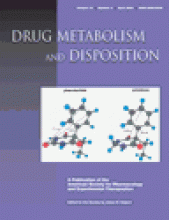Abstract
CYP2C9 is distinguished by a preference for substrates bearing a negative charge at physiological pH. Previous studies have suggested that CYP2C9 residues R97 and K72 may play roles in determining preference for anionic substrates by interaction at the active site or in the access channel. The aim of the present study was to assess the role of these two residues in determining substrate selectivity. R97 and K72 were substituted with negative, uncharged polar and hydrophobic residues using a degenerate polymerase chain reaction-directed strategy. Wild-type and mutant enzymes were expressed in bicistronic format with human cytochrome P450 reductase in Escherichia coli. Mutation of R97 led to a loss of holoenzyme expression for R97A, R97V, R97L, R97T, and R97E mutants. Low levels of hemoprotein were detected for R97Q, R97K, R97I, and R97P mutants. Significant apoenzyme was observed, suggesting that heme insertion or protein stability was compromised in R97 mutants. These observations are consistent with a structural role for R97 in addition to any role in substrate binding. By contrast, all K72 mutants examined (K72E, K72Q, K72V, and K72L) could be expressed as hemoprotein at levels comparable to wild-type. Type I binding spectra were obtained with wild-type and K72 mutants using diclofenac and ibuprofen. Mutation of K72 had little or no effect on the interaction with these substrates, arguing against a critical role in determining substrate specificity. Thus, neither residue appears to play a role in determining substrate specificity, but a structural role for R97 can be proposed consistent with recently published crystallographic data for CYP2C9 and CYP2C5.
Footnotes
-
↵1 Abbreviations used are: P450, cytochrome P450; PCR, polymerase chain reaction; hNPR, human NADPH-cytochrome P450 reductase; ΔAmax, the maximal amplitude of the type I binding spectrum; PDB, Protein Data Bank.
-
This study was supported in part by an Australian Research Council Small Grants Scheme.
- Received September 17, 2003.
- Accepted January 13, 2004.
- The American Society for Pharmacology and Experimental Therapeutics
DMD articles become freely available 12 months after publication, and remain freely available for 5 years.Non-open access articles that fall outside this five year window are available only to institutional subscribers and current ASPET members, or through the article purchase feature at the bottom of the page.
|






